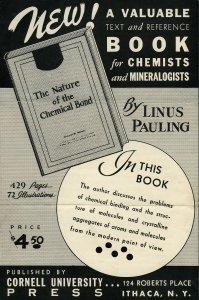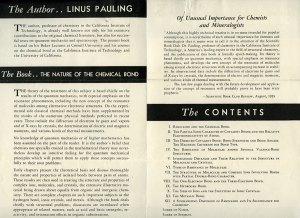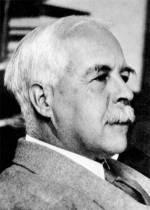
[Celebrating the 75th anniversary of The Nature of the Chemical Bond. Part 5 of 6.]
Once all of the hindrances to getting The Nature of the Chemical Bond printed had finally been overcome, Linus Pauling looked to the next phase – promoting his book. He started by compiling a list of people to whom he wanted to send the text, a list that included those who had helped him along way, journals that would review it, previous Baker Lecturers, and chemistry professors who, Pauling thought, would be interested in using it in their courses. Pauling ultimately came up with a list of sixty-one people, not counting journals.
Cornell University Press chief W. S. Schaefer responded that the press’s policy was to allow for only six free copies, but he could send the book to those on Pauling’s list at a thirty-three percent discount. Pauling explained that he had drafted the list based on previous experiences with McGraw-Hill, which was much looser in doling out free copies. He had Schaeffer remove sixteen individuals from the list, paid for four copies, and claimed that the remaining individuals would most likely use the book in their courses and so should get a copy as a promotional offer. Schaefer agreed to this arrangement, charging the bulk of the books to the advertising budget.
Once The Nature of the Chemical Bond was officially released in May 1939, Cornell did its part in getting the word out. The press sent out an order form addressed to “Students of Chemistry and Molecular Structure” in chemistry departments across the country, alerting them to the opportunity for a ten percent educational discount. The form summarized the material found in The Nature of the Chemical Bond as including “the structure of molecules and crystals, and the nature of the chemical bond,” and emphasized the book’s grounding in quantum mechanics without relying on “mathematical argument in demonstrating the conclusions reached.” It went on to describe how
Early chapters discuss the theoretical basis and the nature and properties of isolated bonds between pairs of atoms. Then complex ions, molecules, and crystals are considered; the extensive illustrative material is drawn about equally from organic and inorganic chemistry. There are complete chapters on such important subjects as the hydrogen bond, ionic crystals, and metals.
The methods used by the author in exploring the nature of the chemical bond include the resonance concept and the techniques of diffraction of electrons by gases and vapors and of X-rays by crystals, the determination of electric and magnetic moments, and various kinds of thermal measurements.
The Press also produced an advertising brochure that expanded upon the information contained in the order form. In addition to noting the book’s basis in quantum mechanics, the brochure promised an “especial emphasis on the resonance phenomenon, including the new concept of resonance of molecules among alternative electronic structures.” It also suggested that The Nature of the Chemical Bond was “of unusual importance for chemists and mineralogists,” quoting from a glowing write-up in the August 1939 Scientific Book Club Review, which declared that “the publication of this book is literally epoch making.” The journal also described how Pauling’s final chapter, which he added at the very last minute, dealt “with the future development and application of the concept of resonance” and “will probably prove to have been truly prophetic.”

By June and July, readers began corresponding with Pauling about the book. The initial responses, mostly from academics, thanked Pauling for sending a complimentary copy and were generally positive in their evaluation. Many mentioned how they, or someone in their department, planned to use Pauling’s book in an upcoming course. Earl C. Gilbert of Oregon State College, for example, told Pauling that the text would “be very successful and fill quite a need” and found Pauling’s account of hydrogen bond properties in particular to be a “convincing treatment” in comparison to Jack Sherman and J. A. A. Ketelaar’s application of quantum mechanics to the carbon-chlorine bond.
Joseph E. Mayer of Columbia University was more effusive in his praise, writing, “It’s the first book that I’ve read through for years!” C. P. Smyth issued a similar response, telling Pauling in mid-October
As evidence of my interest in it I can cite the fact that it is the first scientific book which I can remember reading during the course of a fishing trip, although I have carried many with me in the past.

G.N. Lewis, ca. 1930.
Pauling also received encouragement from a former mentor, Gilbert N. Lewis at Berkeley, who wrote in August,
I have returned from a short vacation for which the only books I took were a half a dozen detective stories and your ‘Chemical Bond’. I found yours the most exciting of the lot.
Pauling appreciated the responses and was particularly glad that Lewis was happy. He had dedicated the book to Lewis and explained “that I had you in mind continually while it was being written, and I have been hoping that my treatment would prove acceptable to you.”
Along with the praise, Pauling also received constructive advice, which he was eager to incorporate into a second edition. Joseph Mayer mentioned that the book needed some work regarding its discussion of metals. Gerold Schwarzenbach of the University of Zurich was also appreciative, but Pauling responded to his note by saying that he “hoped to give proper discussion of” Schwarzenbach’s findings on acid strengths “in a revised edition of my book.” Pauling likewise pressed others for deeper input. He asked Oliver Wulf, who earned his Ph.D. from Caltech in 1926 and would return to Pasadena in 1945, for suggestions on the hydrogen bond spectra, Wulf’s area of interest.
By mid-October, buoyed by all of the responses he was receiving, Pauling began to suspect that he might have a hit on his hands. Curious about sales numbers, he wrote to Schaefer at Cornell University Press for an update and also asked for an interleaved copy which he could use to plan out the next edition.
